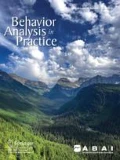Abstract
Educators use a mastery criterion to evaluate skill acquisition programming for children with autism and other developmental disabilities; however, to the best of our knowledge, there has been no research evaluating how the mastery criterion level of accuracy affects the maintenance of those responses. This study investigated the effects of 3 skill acquisition mastery criterion levels (50%, 80%, and 90% accuracy) on response maintenance. Following mastery of a set of skills, maintenance was evaluated once a week for 3 to 4 weeks. Three elementary school–age children diagnosed with autism participated. Overall, the outcomes suggested that higher mastery criterion levels (90% correct) produced higher levels of maintenance responding. Additional research in this area is needed to clarify how different parameters of mastery criterion affect the generality of skills.


Similar content being viewed by others
References
Carlson, J., & Minke, K. (1975). Fixed and ascending criteria for unit mastery learning. Journal of Educational Psychology, 1, 96–101. https://doi.org/10.1037/h0078676
Dolch, E. W. (1948). Problems in reading. Champaign, IL: Garrard.
Dougherty, K. M., & Johnston, J. M. (1996). Overlearning, fluency, and automaticity. The. Behavior Analyst, 19, 289–292.
Fienup, D. M., & Brodsky, J. (2017). Effects of mastery criterion on the emergence of derived equivalence relations. Journal of Applied Behavior Analysis. https://doi.org/10.1002/jaba.416. Advance online publication.
Fry, E. (1994). 1000 instant words: the most common words for teaching reading, writing and spelling. Laguna Beach, CA: Laguna Beach Educational Books.
Haq, S. S., & Kodak, T. (2015). Evaluating the effects of massed and distributed practice on acquisition and maintenance of tacts and textual behavior with typically developing children. Journal of Applied Behavior Analysis, 48, 85–95. https://doi.org/10.1002/jaba.178
Ivarie, J. J. (1986). Effects of proficiency rates on later performance of a recall and writing behavior. Remedial and Special Education, 7, 25–30.
Johnston, J. M., & O’Neill, G. (1973). The analysis of performance criteria defining course grades as a determinant of college student academic performance. Journal of Applied Behavior Analysis, 6, 261–268.
Kocher, C. P., Howard, M. R., & Fienup, D. M. (2015). The effects of work-reinforcer schedules on skill acquisition for children with autism. Behavior Modification, 39, 600–621. https://doi.org/10.1177/0145445515583246
Majdalany, L. M., Wilder, D. A., Greif, A., Mathisen, D., & Saini, V. (2014). Comparing massed-trial instruction, distributed-trial instruction, and task interspersal to teach tacts to children with autism spectrum disorders. Journal of Applied Behavior Analysis, 47, 657–662. https://doi.org/10.1002/jaba.149
Majdalany, L. M., Wilder, D. A., Smeltz, L., & Lipschultz, J. (2016). The effects of brief delays to reinforcement on the acquisition of tacts in children with autism. Journal of Applied Behavior Analysis, 49, 411–415. https://doi.org/10.1002/jaba.282
Paden, A. R., & Kodak, T. (2015). The effects of reinforcement magnitude on skill acquisition for children with autism. Journal of Applied Behavior Analysis, 48, 924–929. https://doi.org/10.1002/jaba.239
Semb, G. (1974). The effects of mastery criteria and assignment length on college-student test performance. Journal of Applied Behavior Analysis, 1, 61–69.
Ward-Horner, J. C., Cengher, M., Ross, R. K., & Fienup, D. M. (2017). Arranging response requirements and the distribution of reinforcers: a brief review of preference and performance outcomes. Journal of Applied Behavior Analysis, 50, 181–185. https://doi.org/10.1002/jaba.350
Author information
Authors and Affiliations
Corresponding author
Ethics declarations
The research was approved by the institutional review board of the affiliated university. All parents of participants provided informed consent for the children to participate in this study.
Author Note
The study was conducted by the first author in partial fulfillment of a master’s degree in applied behavior analysis at Queens College, City University of New York. The authors wish to thank Julia Brodsky and Bryan Tyner for their helpful comments on the manuscript.
Conflict of Interest
The authors declare that they have no conflicts of interest.
Rights and permissions
About this article
Cite this article
Fuller, J.L., Fienup, D.M. A Preliminary Analysis of Mastery Criterion Level: Effects on Response Maintenance. Behav Analysis Practice 11, 1–8 (2018). https://doi.org/10.1007/s40617-017-0201-0
Published:
Issue Date:
DOI: https://doi.org/10.1007/s40617-017-0201-0




